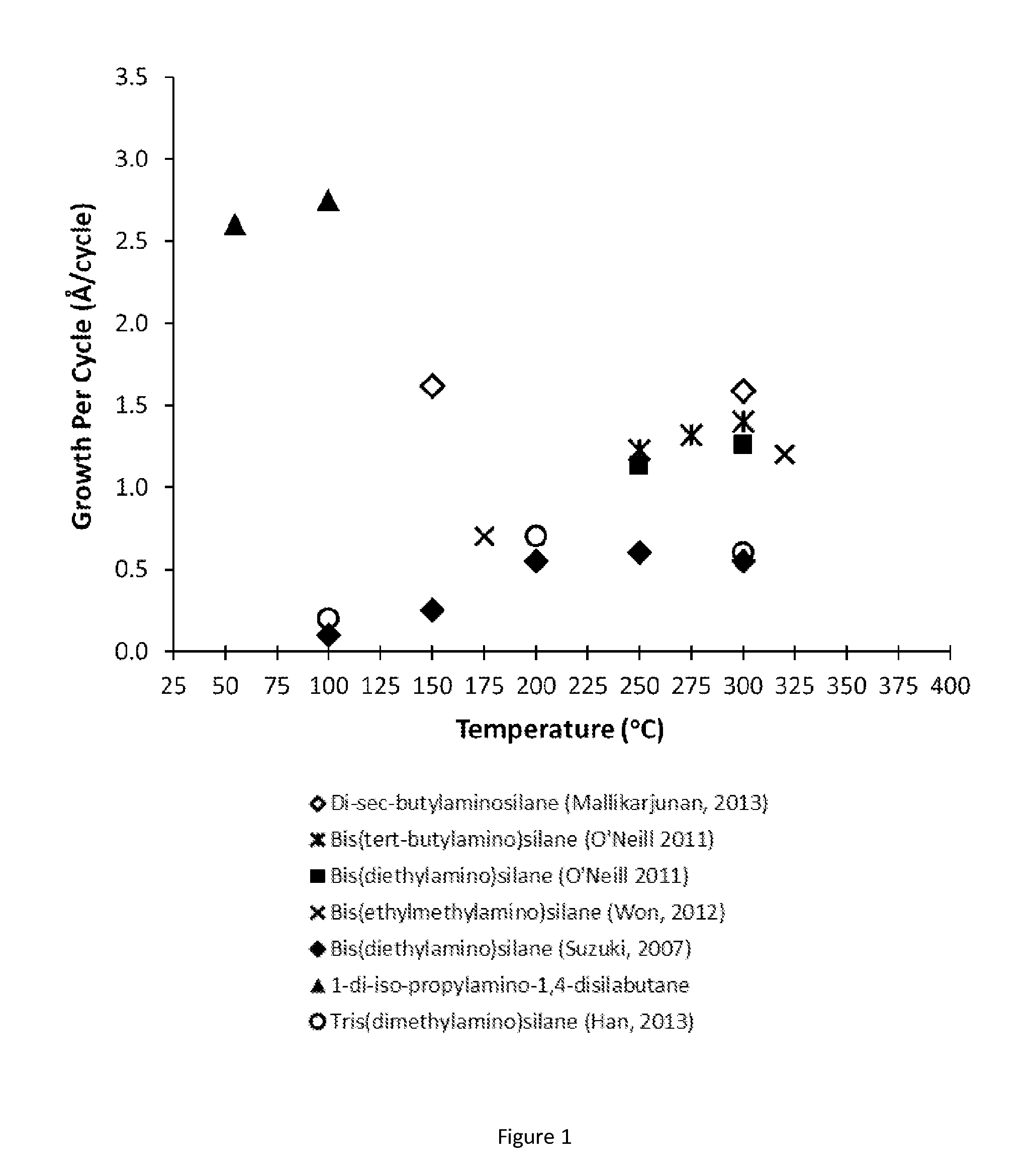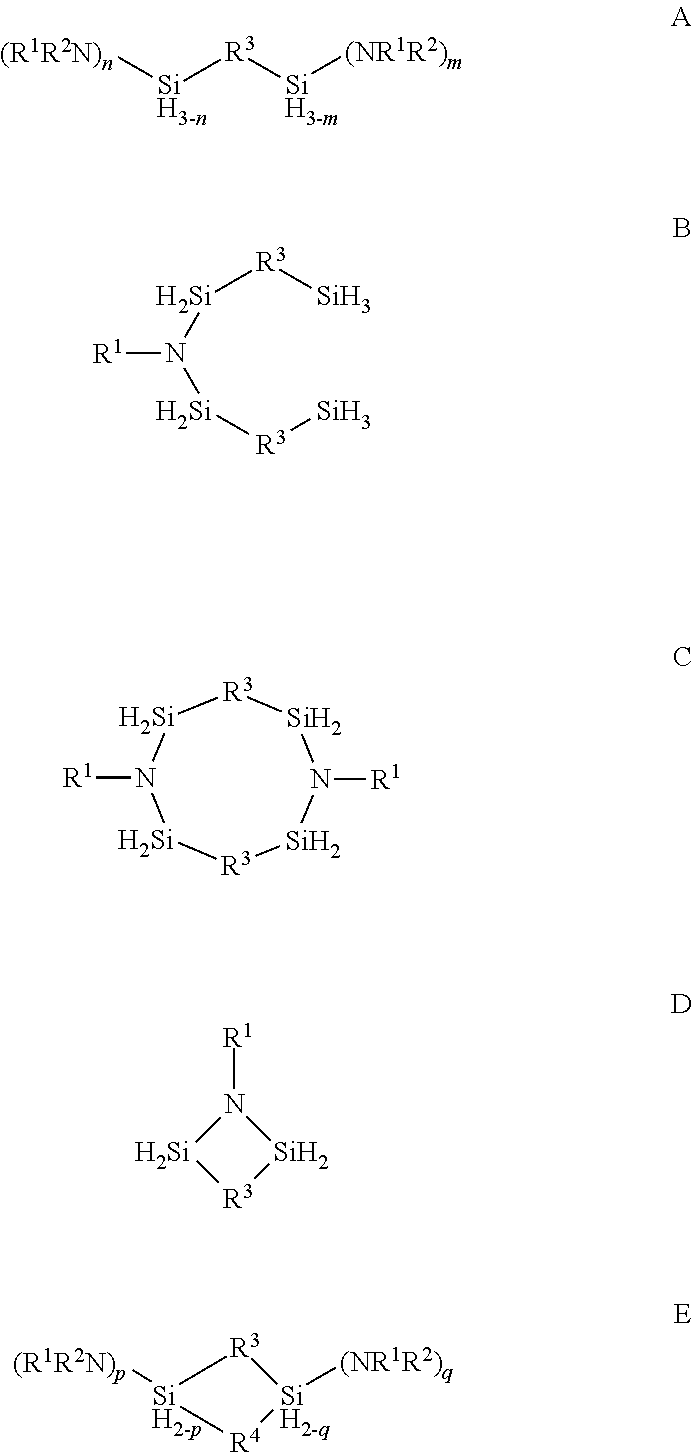Organoaminosilane precursors and methods for depositing films comprising same
- Summary
- Abstract
- Description
- Claims
- Application Information
AI Technical Summary
Benefits of technology
Problems solved by technology
Method used
Image
Examples
example 1
Synthesis of 1-di-iso-propylamino-1,4-disilabutane
[0145]In a 3-necked round bottom flask equipped with a mechanic stirrer, a condenser, and an addition funnel, a solution of 1 equivalent 1,4-disilabutane in hexane was cooled to −20° C. with a cold bath. With stirring, a solution of 0.5 equivalent of lithium diisopropylamide in tetrahydrofuran (THF) was added dropwise through the addition funnel. After the addition was completed, the reaction mixture was allowed to warm up to room temperature. The reaction mixture was stirred at room temperature overnight, followed by filtration. A white precipitate, lithium hydride, formed from the reaction as a byproduct was filtered out. The solvent in the filtrate and excess 1,4-disilabutane was removed by distillation. The product, 1-di-iso-propylamino-1,4-disilabutane, was obtained by vacuum distillation. Gas chromatography (GC) showed that it was >98% pure 1-di-iso-propylamino-1,4-disilabutane. GC-MS showed the following peaks: 189 (M+), 188 (...
example 2
Synthesis of 1-t-butyl-1-aza-2-5-disilacyclopentane
[0146]In a 3-necked round bottom flask equipped with a mechanic stirrer, a condenser, and an addition funnel, a solution of 1 equivalent of 1,4-disilabutane in hexane was cooled to −20° C. with a cold bath. With stirring, a solution of 0.5 equivalent of lithium t-butylamide in THF was added dropwise through the addition funnel. After the addition was completed, the reaction mixture was allowed to warm up to room temperature. The reaction mixture was stirred at room temperature overnight, followed by filtration. A white precipitate, lithium hydride, formed from the reaction as a byproduct was filtered out. The solvent in the filtrate and the excess 1,4-disilabutane were removed by distillation. The product, 1-t-butyl-1-aza-2-5-disilacyclopentane, was obtained by vacuum distillation. Gas chromatography (GC) showed that it was >98% pure. GC-MS showed the following peaks: 159 (M+), 158 (M−1), 144 (M−15), 128, 114, 100.
example 3
Synthesis of 1,4-bis(di-iso-propylamino)-1,4-disilabutane
[0147]In a 3-necked round bottom flask equipped with a mechanic stirrer, a condenser, and an addition funnel, a solution of 0.5 equivalent 1,4-disilabutane in hexane was cooled to −20° C. with a cold bath. With stirring, a solution of 1 equivalent of lithium di-iso-propylamide in THF was added dropwise through the addition funnel. After the addition was completed, the reaction mixture was allowed to warm up to room temperature. The reaction mixture was stirred at room temperature overnight, followed by filtration. A white precipitate, lithium hydride, formed from the reaction as a byproduct was filtered out. The solvent in the filtrate was removed by distillation. The product, 1,4-bis(di-iso-propylamino)-1,4-disilabutane, was obtained by vacuum distillation. B.P. 124° C. / 1 torr. GC-MS showed the following peaks: 288 (M+), 287 (M−1), 243, 229, 207, 188, 144, 130. 1H NMR: 4.59 (s, 4H), 3.03 (m, 4H), 1.08 (d, 24H), 0.73 (t, 4H). ...
PUM
| Property | Measurement | Unit |
|---|---|---|
| Temperature | aaaaa | aaaaa |
| Temperature | aaaaa | aaaaa |
| Temperature | aaaaa | aaaaa |
Abstract
Description
Claims
Application Information
 Login to View More
Login to View More - R&D
- Intellectual Property
- Life Sciences
- Materials
- Tech Scout
- Unparalleled Data Quality
- Higher Quality Content
- 60% Fewer Hallucinations
Browse by: Latest US Patents, China's latest patents, Technical Efficacy Thesaurus, Application Domain, Technology Topic, Popular Technical Reports.
© 2025 PatSnap. All rights reserved.Legal|Privacy policy|Modern Slavery Act Transparency Statement|Sitemap|About US| Contact US: help@patsnap.com



